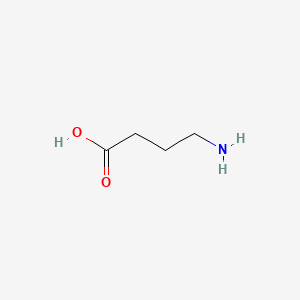| MeSH term | MeSH ID | Detail |
|---|---|---|
| Peripheral Nervous System Diseases | D010523 | 33 associated lipids |
| Fetal Diseases | D005315 | 8 associated lipids |
| Multiple Sclerosis | D009103 | 13 associated lipids |
| Cerebral Hemorrhage | D002543 | 13 associated lipids |
| Nervous System Diseases | D009422 | 37 associated lipids |
| Hypoparathyroidism | D007011 | 2 associated lipids |
| Ataxia | D001259 | 20 associated lipids |
| Brain Edema | D001929 | 20 associated lipids |
| Alcoholism | D000437 | 27 associated lipids |
| Starvation | D013217 | 47 associated lipids |
4-aminobutyric acid
4-aminobutyric acid is a lipid of Fatty Acyls (FA) class. 4-aminobutyric acid is associated with abnormalities such as Epilepsy and Premenstrual syndrome. The involved functions are known as Binding (Molecular Function), neuron survival, Process, Uptake and physiological aspects. 4-aminobutyric acid often locates in Microglial, Neurofilament, Neuraxis, Brain region and Neurites. The associated genes with 4-aminobutyric acid are arginine methyl ester, SLC33A1 gene, NKS1 gene, P4HTM gene and ITSN2 gene. The related lipids are pregnenolone sulfate, pregnane-20-one, Pregnanes, Steroids and endogenous steroids.
Cross Reference
Introduction
To understand associated biological information of 4-aminobutyric acid, we collected biological information of abnormalities, associated pathways, cellular/molecular locations, biological functions, related genes/proteins, lipids and common seen animal/experimental models with organized paragraphs from literatures.
What diseases are associated with 4-aminobutyric acid?
4-aminobutyric acid is suspected in Premenstrual syndrome, Epilepsy and other diseases in descending order of the highest number of associated sentences.
Related references are mostly published in these journals:
| Disease | Cross reference | Weighted score | Related literature |
|---|
Possible diseases from mapped MeSH terms on references
We collected disease MeSH terms mapped to the references associated with 4-aminobutyric acid
PubChem Associated disorders and diseases
What pathways are associated with 4-aminobutyric acid
There are no associated biomedical information in the current reference collection.
PubChem Biomolecular Interactions and Pathways
Link to PubChem Biomolecular Interactions and PathwaysWhat cellular locations are associated with 4-aminobutyric acid?
Visualization in cellular structure
Associated locations are in red color. Not associated locations are in black.
Related references are published most in these journals:
| Location | Cross reference | Weighted score | Related literatures |
|---|
What functions are associated with 4-aminobutyric acid?
Related references are published most in these journals:
| Function | Cross reference | Weighted score | Related literatures |
|---|
What lipids are associated with 4-aminobutyric acid?
Related references are published most in these journals:
| Lipid concept | Cross reference | Weighted score | Related literatures |
|---|
What genes are associated with 4-aminobutyric acid?
Related references are published most in these journals:
| Gene | Cross reference | Weighted score | Related literatures |
|---|
What common seen animal models are associated with 4-aminobutyric acid?
There are no associated biomedical information in the current reference collection.
NCBI Entrez Crosslinks
All references with 4-aminobutyric acid
Download all related citations| Authors | Title | Published | Journal | PubMed Link |
|---|---|---|---|---|
| Scharfman HE and MacLusky NJ | Differential regulation of BDNF, synaptic plasticity and sprouting in the hippocampal mossy fiber pathway of male and female rats. | 2014 | Neuropharmacology | pmid:23660230 |
| Vashchinkina E et al. | Neurosteroid Agonist at GABAA receptor induces persistent neuroplasticity in VTA dopamine neurons. | 2014 | Neuropsychopharmacology | pmid:24077066 |
| Mango D et al. | Phosphodiesterase 10A controls D1-mediated facilitation of GABA release from striato-nigral projections under normal and dopamine-depleted conditions. | 2014 | Neuropharmacology | pmid:23973317 |
| Chou HT et al. | Functional characterization of the agtABCD and agtSR operons for 4-aminobutyrate and 5-aminovalerate uptake and regulation in Pseudomonas aeruginosa PAO1. | 2014 | Curr. Microbiol. | pmid:23982201 |
| Kumar A et al. | Hesperidin potentiates the neuroprotective effects of diazepam and gabapentin against pentylenetetrazole-induced convulsions in mice: Possible behavioral, biochemical and mitochondrial alterations. | 2014 May-Jun | Indian J Pharmacol | pmid:24987179 |
| Rizk NN et al. | Use of topical lidocaine, diphenhydramine hydrochloride, nystatin, and gabapentin swish in treatment for post-radiation neuropathy and oral mucositis. | 2014 May-Jun | Pain Physician | pmid:24850125 |
| Bönnighausen J et al. | Disruption of the GABA shunt affects mitochondrial respiration and virulence in the cereal pathogen Fusarium graminearum. | 2015 | Mol. Microbiol. | pmid:26305050 |
| Groundwater PW et al. | The Differential Effects of Resveratrol and trans-ε-Viniferin on the GABA-Induced Current in GABAA Receptor Subtypes Expressed in Xenopus Laevis Oocytes. | 2015 | J Pharm Pharm Sci | pmid:26626239 |
| Lee KH et al. | Bidirectional Signaling of Neuregulin-2 Mediates Formation of GABAergic Synapses and Maturation of Glutamatergic Synapses in Newborn Granule Cells of Postnatal Hippocampus. | 2015 | J. Neurosci. | pmid:26674872 |
| Wang H et al. | Cocaine-Induced Endocannabinoid Mobilization in the Ventral Tegmental Area. | 2015 | Cell Rep | pmid:26365195 |
